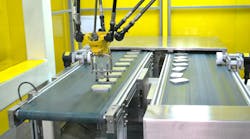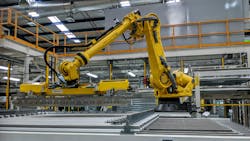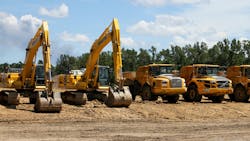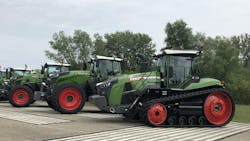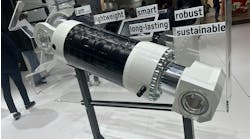What you'll learn in this article:
- How tariffs are impacting market forecasts.
- Market expectations for industrial and mobile machinery.
- What first quarter results say about current and future market dynamics.
The tariff policy put in place by the Trump administration is impacting the market outlook for many sectors, including the industrial and mobile machinery markets important to the fluid power industry. Continually changing tariff rates, affected products, and retaliatory tariffs from other countries is causing a lot of uncertainty for companies.
Business planning is now more difficult for companies because of the swift changes being made to the trade policy on a sometimes day-to-day and week-to-week basis.
Many expected 2025 to be a better year for the hydraulics and pneumatics industry as well as its customer markets due in part to the easing of interest rates which was anticipated to help improve demand for machinery and components.
However, the ever-evolving tariff situation is causing many companies to maintain a wait-and-see mentality, leading many to re-evaluate expectations for the global economy. During the National Fluid Power Association's (NFPA) spring economic webinar held May 1, presenter Francesco Chirillo, Senior Economist in Global Industry Services at Oxford Economics, said his organization recently cut its forecasts for global GDP growth because of the difficulty tariffs are expected to present to various global regions.
Forecasts for the industrial and mobile machinery markets have been adjusted as well, again due to the current tariff environment and the high level of uncertainty it is creating. As these are the two key sectors served by hydraulics and pneumatics, understanding current conditions and market expectations can help fluid power companies with their own business planning.
Read the below articles for more on the initial predictions for market recovery in 2025.
Business Sentiment Shifts Negative for Industrial Machinery Market
The industrial machinery market started 2025 on a positive note. Market intelligence firm Interact Analysis noted that the U.S. manufacturing sector began 2025 on a better note, indicating it was starting to exit the wait-and-see period it had entered in 2024.
This positivity was reflected in orders for industrial equipment. New orders for metalworking machinery, for instance, were up in both January and February according to figures shared by the Association for Manufacturing Technology (AMT) on April 14.
However, the U.S. government’s tariff policies appear to have dampened that positivity.
As reported by IndustryWeek, an Endeavor Business Media partner site, manufacturing activity in the U.S. contracted in March and again in April 2025 after starting the year in expansion territory per the Institute for Supply Management (ISM) manufacturing index; tariff uncertainty is cited as the reason business confidence began to wane.
Another recent report from IndustryWeek highlights the pessimistic outlook of the manufacturing sector, much of which was prompted by the Trump administration’s announcement of sweeping tariffs for all major trading partners on April 2. IndustryWeek assessed several business outlook surveys released in mid-April which showed plans to increase capital spending have declined from earlier in the year because of uncertainty about the economy.
Due to these changes in market dynamics, demand for industrial machinery and the components utilized within it is likely to be lower.
The second quarter (Q2) update to the 2025 Equipment Leasing & Finance U.S. Economic Outlook shows a similar picture. Per the Equipment Leasing & Finance Foundation — a non-profit organization supporting the equipment finance sector — which puts together the outlook, declines in consumer and business sentiment as well as rising inflation expectations and policy uncertainties prompted a revision of its initial outlook.
In the Q2 report, the foundation revised its 2025 equipment and software investment forecast to 2.8% (down from 4.7%) and its U.S. GDP forecast to 1.2% (down from 2.7%). Overall, it is predicting a pause in growth is the most likely outcome by the end of 2025.
The Equipment Leasing & Finance Foundation also noted the improvements seen in recent months in the manufacturing sector. It said shipments and new orders of core capital goods were generally positive, although some of this could be due to pre-buying ahead of tariffs going into place.
“Extraordinarily high economic uncertainty related to U.S. trade policy has sent shockwaves through the economy, prompting large swings in financial markets and a sharp reduction in equipment finance industry confidence,” said Leigh Lytle, President of the Foundation, and President & CEO of the Equipment Leasing and Finance Association. “At the same time, labor markets remain healthy, consumer spending bounced back in March, and the manufacturing sector appears to be holding its own.
“The elephant in the room is tariffs: if the administration ultimately moves forward with the ‘reciprocal’ tariff rates announced in early April, they will weigh heavily on the economy’s growth prospects this year. On the other hand, if bilateral or multilateral deals are struck with key trading partners and these additional tariffs are avoided, the business climate would quickly improve.”
In its discussions with machinery manufacturers, Interact Analysis said it has found there is a high level of uncertainty about the duration of tariffs and their targets. This is making it difficult for companies to make long-term plans and large investments which the research firm said will negatively impact industrial production.
Contraction for the year is not yet a guarantee for the industrial machinery market said Interact Analysis, but continued uncertainty will also not lead to growth for the sector in 2025. It did note though that if the Trump administration takes a more nuanced approach to its trade policy sooner than later then there is the potential for slight growth to occur in 2025 for this market.
Watch the video below for Power & Motion's discussion with other editors from Endeavor Business Media to learn how we are seeing tariffs so far impacting the industries we cover — including the fluid power, electronics and broader manufacturing sectors.
Mobile Equipment Demand to Remain Low Due to Higher Prices Caused by Tariffs
The mobile machinery market — which includes construction equipment, agricultural equipment, forklifts and other heavy-duty machines — was also expected to recover in 2025. Here again though, the U.S.’s tariff policies could hamper demand for these machines and the components utilized within them such as hydraulics and pneumatics.
As Interact Analysis explained in its most recent analysis of the mobile equipment market, tariffs are likely going to increase machinery prices, leading to lower demand and a challenging situation again for the sector in 2025.
Construction Equipment Sales Expected to Stay Down
Data from Interact Analysis is already showing a sluggish start to the year for construction equipment, with it reporting new orders in the U.S. have so far trended downwards and inventories remain high. Construction spending is trending downward and housing permits remain flat, posing potential demand challenges for this machinery sector.
Volvo Construction Equipment recently reported its first quarter 2025 results which saw a global sales drop of 8%. The OEM noted growth was seen in South America and Asia, but declines in Europe and North America due to geopolitical and market uncertainty were key drivers for its lower sales volume during the quarter.
Construction Equipment, another Endeavor Business Media partner site, reports a similar situation for Caterpillar Inc. which recorded a 10% sales drop for Q1 2025. The company is closely watching the tariff situation and sees the potential for them to add costs as well as lower sales if deals are not reached with trading partners.
In addition to its economic outlook report, the Equipment Leasing & Finance Foundation also released the Foundation-Keybridge U.S. Equipment & Software Investment Momentum Monitor which tracks seven equipment and software investment verticals. Construction machinery is one of these verticals, and investment growth is expected to remain negative for this sector per the Q2 Momentum Monitor.
Mixed Signals in Global Economy to Continue Challenging Agricultural Equipment Market
According to the Equipment Leasing & Finance Foundation’s Q2 Momentum Monitor, agricultural machinery, which experienced tough market conditions through much of 2024, may see modest improvements to investment growth but is likely to remain weak overall.
The Association of Equipment Manufacturers’ (AEM) most recent data for the agricultural equipment market shows sales for tractors and combines in Canda rose in March 2025. U.S. sales for these same machines, however, continued their downward trend. Uncertainty about tariffs and the overall farming economy were noted among the challenges facing the U.S. agricultural market by Curt Blades, AEM Senior Vice President.
Agricultural equipment manufacturer AGCO Corp. announced its first quarter 2025 results on May 1 which show a 30% decrease in sales compared to the same period in 2024. Eric Hansotia, AGCO's Chairman, President and Chief Executive Officer, said the company’s cost and inventory reduction efforts are helping it whether the current global trade environment.
“We are seeing a mix of positive signs and risks around the world, requiring us to remain agile…,” he said. “The underlying fundamentals in many parts of the world have begun to trend upward with farmer sentiment in Europe improving, U.S. corn prices rising and corn stocks-to-use-ratios at lower levels. However, the global agricultural equipment market is volatile due to tariffs and shifting export demand for grain.”
The company is anticipating lower sales volumes in 2025 as well as potential impacts from tariffs such as increased input costs, though it does not have a full picture yet on those impacts since the tariff situation continues to evolve and AGCO is looking for ways to mitigate those impacts where possible.
CNH Industrial, which develops both construction and agricultural equipment, also announced its first quarter 2025 results on May 1. It too reported lower revenue and sales compared to the same period in 2024. Like other OEMs, CNH has been focusing on reducing dealer inventories and managing operational costs to help weather the current economic climate.
For its agricultural segment, CNH said sales in the first quarter declined 23% due to lower shipment volumes because of decreased industry demand in all regions as well as dealer destocking. The company is currently forecasting global retail sales for both agriculture and construction equipment to be lower than those in 2024 due to a combination of lower cyclical industry sales and the potential impacts of tariffs.
